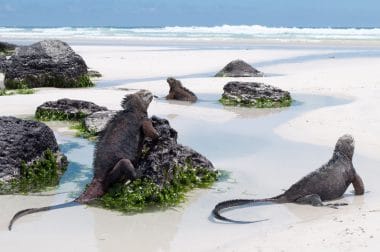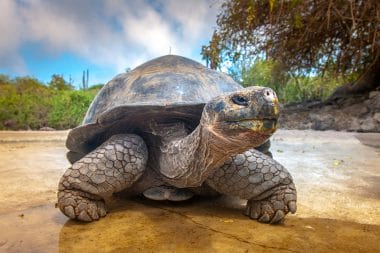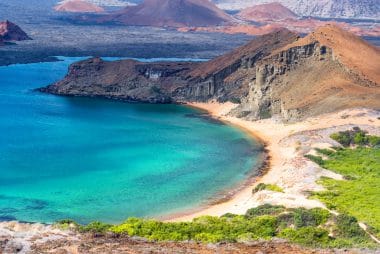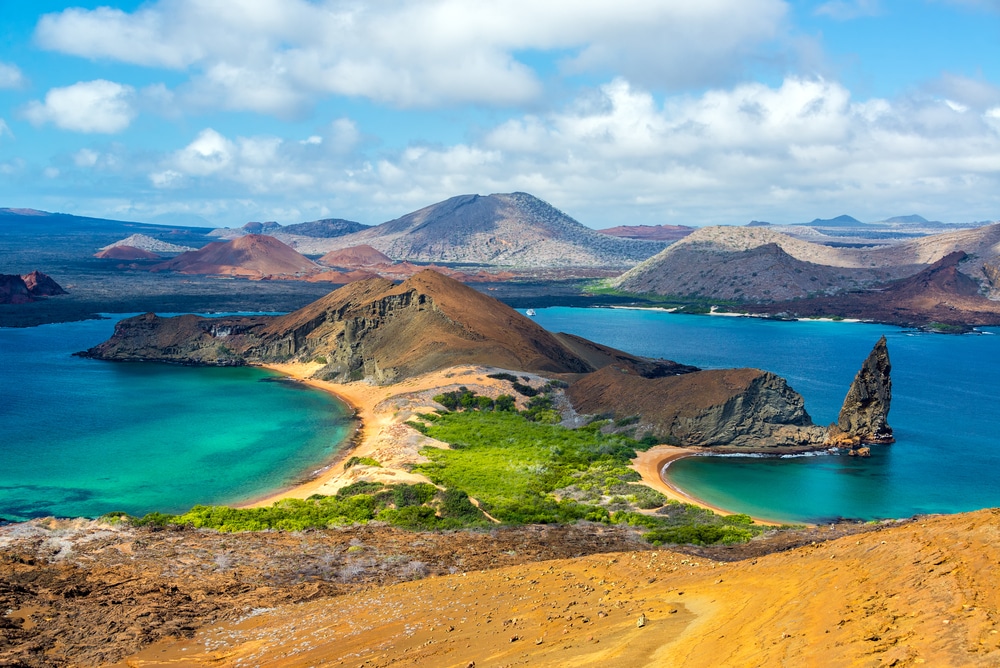The Galapagos Islands are among the most famous archipelagos in the world. Above all, the extraordinary flora and fauna, which is also a UNESCO World Heritage Site, contribute to the level of fame. In particular, the Galapagos giant tortoises, which only occur on these islands, are well-known. This archipelago also owes its name to them. Galapago is Spanish and means “bulging saddle” and refers to the special shape of the shell of this turtle genus. Even though tourism is now the largest source of income on the Galapagos Islands, they can still be described as an insider tip.
General data about the Galapagos Islands
About 130 islands belong to the Galapagos Islands. However, only 13 of these islands have an area of 10km² or more. In total, the islands cover an area of about 80,000 km². Five of the islands are inhabited: Santa Cruz, San Cristobal, Isabela, Floreana and Baltra. A total of about 25,000 people live here. Baltra has no real settlement, but only a military base for about 400 soldiers.
History of the Galapagos Islands

Sights of the Galapagos Islands
A holiday on the Galapagos Islands is only complete when a wide variety of archipelagos, some of them tiny, have been visited and a whole army of different animals has been observed. Pure nature is the motto here – because the Galapagos Islands have plenty of it to offer. Among the most interesting islands are:
Isabela

Floreana
This island is known less for its nature than for its history. Of course, that doesn’t mean it’s not beautiful to look at (it’s just that there aren’t unique natural spectacles like on other islands). In the 17th century, Floreana was settled by pirates. There were two main reasons for this choice:
- The Spanish gold ships had to pass nearby on their way back to Europe and
- The island offered hiding places and even more important: drinking water!
Darwin & Wolf Islands

Plaza Sur
A nice little trip can also be made to the island of Plaza Sur. The crater of a volcano forms a natural harbor basin where the excursion boats can dock. A circular hiking trail across the island offers the opportunity to observe sea lions, lizards, birds but also rare plants such as Sesuvium.
Important information for your trip to the Galapagos Islands
1. Travel preparation
- Visa and entry: German citizens do not need a visa for Ecuador, including the Galapagos Islands, for stays of up to 90 days. Your passport must be valid for at least six months.
- Flights: There are no direct flights from Germany to the Galapagos Islands. Usually, you fly to Quito or Guayaquil in Ecuador and from there on to Baltra or San Cristóbal in the Galapagos Islands.
- Transit Control Card (TCT): Upon arrival in Ecuador, you will need to fill out a TCT card (costs about $20 USD). She is checked when entering the islands.
- National Park Entrance Fee: Upon arrival in the Galapagos Islands, you will have to pay a fee of USD 100 (as of 2024) for the national park.
2. Health and safety
- Vaccinations: Standard vaccinations (such as tetanus, hepatitis A) should be up-to-date. Malaria is not common in the Galapagos Islands, but insect repellent is still advisable.
- First-aid kit: Since medical care is limited on the islands, you should bring a well-stocked first-aid kit, including sunscreen, seasickness medication, and gastrointestinal disorders.
- Travel insurance: A good travel insurance with repatriation is recommended, as medical emergencies can be costly.
3. Clothing and equipment
- Awning: The sun in the Galapagos Islands is intense. Bring high SPF sunscreen, a sun hat, and sunglasses.
- Comfortable clothing: Light, breathable clothing for warm weather as well as swimwear and snorkeling equipment (if not provided) are useful. Sturdy hiking shoes are also advisable, as some islands are volcanic and rocky.
- Snorkeling and diving: The waters around the Galapagos Islands are world-famous for their rich marine life. If you want to snorkel or dive, you can rent equipment on site, but your own equipment is often more convenient.
4. Environmental awareness
- Sustainability: Galapagos is a specially protected area. Make sure to respect the strict environmental regulations. Avoid plastic waste, keep your distance from the animals and do not touch them.
- Water scarcity: Fresh water is scarce on the islands. Avoid unnecessary water consumption and use reusable water bottles.
5. Travel time
- Best time to travel: The Galapagos Islands can be visited all year round. The warm months (December to May) offer more pleasant temperatures and calmer waters, ideal for snorkeling. The cooler season (June to November) is ideal for wildlife viewing, as more marine life is encountered.
6. Wildlife Observations
- Unique wildlife: The Galapagos Islands are home to many endemic animal species, such as the Galapagos giant tortoise, marine iguanas and blue-footed boobies. A guided tour with a licensed naturalist guide is ideal for learning more about the animals.
7. Island hopping
- Transport: The islands are only connected by boat or plane. Island hopping is a popular way to explore multiple islands. Find out in advance about ferry times and internal flights, especially in high season.


